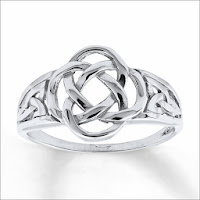The Claddagh Design
Usually designated for use as an engagement ring, the Claddagh is a traditional design that is specifically for women. Traditionally, the design depicts two hands holding a heart, but the design can vary depending on region and the artist’s particular style. The intent of the design is to symbolize the dedication and pledge that one takes when making their wedding vows and this has led to it being the most popular choice for Irish engagement rings. The design is one of the most traditional in Irish culture, and just by wearing it a woman can display her relationship status whether it is love, loyalty, or friendship. What the ring indicates precisely varies depending on how the ring is worn, and those are as follows:
- If the ring is on her right hand with the point of the heart away from the body, it means she is single. The Claddagh is one of the most popular Irish wedding rings, but it can also be passed down from mother to daughter and can be worn by single women.
- If the ring is on her right hand with the point of the heart towards her, she is in a relationship, but not yet engaged. Having the heart inwards, so it appear right side up from the wearer’s perspective, means the woman’s heart has been captured.
- If the ring is on her left hand with the point of the heart away from her body, she is engaged.
- If the ring is on her left hand with the point of the heart towards her, she is married.
The Celtic Knot
Undoubtedly the most recognized of all Irish wedding ring styles, there are countless variations on this classic style. While they all appear similar and are instantly recognized if seen alone, you can certainly see the variations if you compare a few rings next to each other. The most common design for an Irish wedding ring is the “infinite knot” which is a very old and traditional Christian symbol that stands for the intertwining lives of bride and groom that lasts for all of eternity. Most couples end up purchasing their Irish wedding rings with the “infinite knot” style of Celtic knot because they are the most common, most traditional, and offer the most variations from which to choose.

This comment has been removed by a blog administrator.
ReplyDeleteThis comment has been removed by a blog administrator.
ReplyDelete